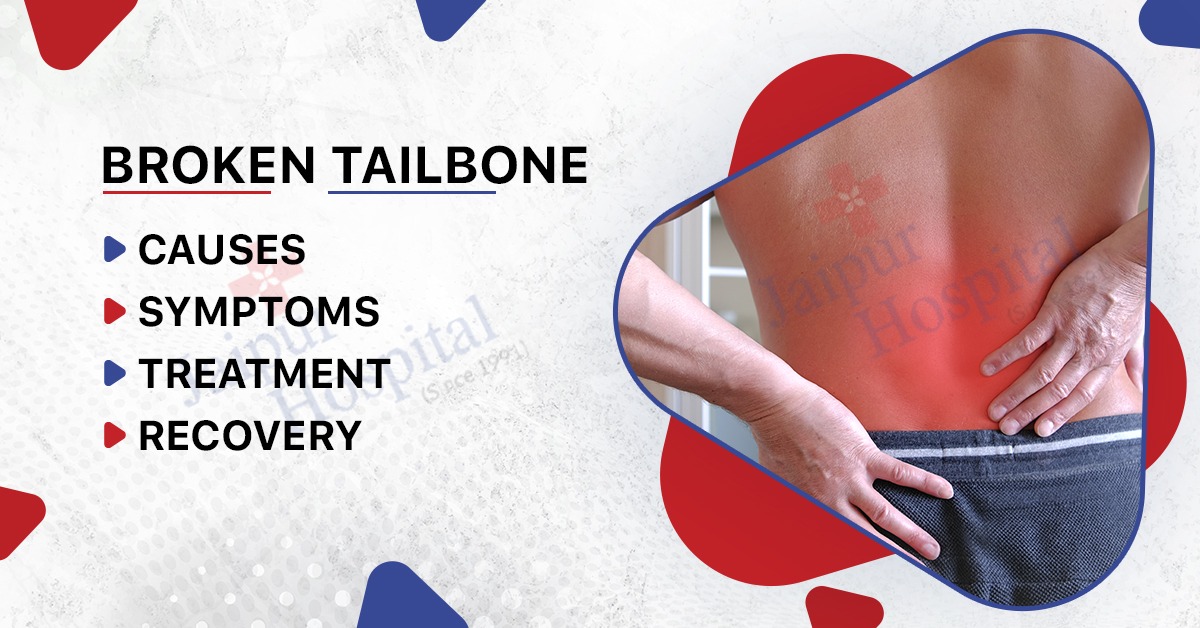Overview
While in certain situations, such as sitting or going to the toilet, a fractured or injured tailbone can cause pain.
The bottom end of your spine is made up of a collection of tiny bones called the tailbone, or coccyx. The tailbone consists of three to five vertebrae, depending on the individual. This small collection of bones comes to a gentle point. The vertebrae are ordinarily fused, except for the first segment.
The human coccyx is bent under, although each person’s degree of curvature is unique. Your coccyx bears some of the weight of your upper body when you sit down. Coccyx injuries or breaks can be excruciatingly painful, especially when you sit down.
The enormous gluteus maximus muscle, as well as several other muscles and ligaments, are all connected to the tailbone.
Particularly during and after pregnancy, women have a five times greater likelihood of experiencing tailbone discomfort than men do. Also, if you have osteopenia you are more vulnerable (bone deterioration). Coccyx injuries are frequently caused by automobile accidents.
Causes of Broken Tailbone
There are various causes of broken Tailbone, some of them are as follows:
Falling
How many of us have tripped over and landed on our behinds? The ice may have caused you to lose your footing. It may have the possibility that you fell from a ladder. If you were leaning too far forward in your workplace chair, you may have fallen out. Occasionally, your tailbone can be fractured, broken, or knocked out of place (coccyx) when you fall hard.
Repetitive Strain Injury (RSI)
It’s necessary to slouch and stretch your spine while participating in sports like rowing and cycling. The tissues surrounding your coccyx may become strained if you perform that motion too frequently.
Pregnancy/Childbirth
Pregnant women’s bodies secrete hormones that soften the region between the sacrum and the coccyx during the third trimester. Due to this, the coccyx can move during birth as necessary.
As a result of this motion, the ligaments and muscles surrounding the coccyx may be stretched unnecessarily, resulting in increased discomfort. Under such stress, your soft tissues are unable to maintain the proper angle of your coccyx.
Obesity
The coccyx is under more pressure due to extra weight. This leads to the coccyx slanting backward. If your tailbone isn’t in its proper place, it will hurt.
Underweight
When the coccyx rubs against muscles, ligaments, and tendons due to insufficient fat in the buttocks, it can cause this condition. Soft tissues become inflamed from the rubbing.
Chordoma
When a cancerous tumor develops on the tip of the tailbone, skull, or spinal cord, the condition is called chordoma. In addition to relieving joint pressure, it can cause pain in the tailbone as cancer spreads. The cartilage in the tailbone may deteriorate as a result, and nearby joints may become inflamed. Its symptoms include a noticeable increase in mass, groin numbness, bladder problems, and weakness in the legs.
Sitting
Coccyx pain can be aggravated by even small movements, especially when seated on hard or constrained surfaces. Stay active by getting up frequently, stretching, and walking a little bit. Better yet, use a padded seat or find a place to sit that is softer and more comfortable.
Cancer
An indication of cancer in the tailbone is rare. It is highly improbable.
You can also read:- 10 Ways to Improve Gut Health
Symptoms of Broken Tailbone
You might have a bruised or broken tailbone if you experience tenderness or pain when sitting. Other symptoms include:
● mild to severe pain that ranges in tenderness
● noticeable bruising
● swelling
● having discomfort when lying down or squatting
● sitting causes more discomfort
● bowel movements that hurt
● urinary incontinence
● legs that are weakened or numb
● a lower back ache
Long-lasting symptoms of a broken tailbone are possible. As a result, it is crucial to have medical personnel examine you after an accident, especially if you are still experiencing pain.
Diagnosis of Broken Tailbone
The diagnosis of a broken tailbone requires a doctor to review the patient’s medical history, perform a physical examination, and order tests because a variety of conditions and factors can cause pain around the tailbone.
The medical professional will investigate:
● falls and sports injuries are two potential causes of pain.
● potential non-traumatic factors include aging-related wear and tear.
● the possibility of other sources of pain
The doctor will learn more about the location of the discomfort as well as what might be causing or exacerbating it from a physical examination and a rectal examination.
Pain in and around the tailbone can be attributed to issues with the piriformis muscles and surrounding joints, such as the sacroiliac and lumbosacral facet joints.
Cancer screening and diagnostic imaging will be part of the tailbone fracture examination.
A doctor can locate and evaluate the tailbone’s damage with the aid of X-rays. An MRI scan can reveal more details if the X-ray cannot produce a clear image or if there are other questions regarding the source of the pain.
It is not always simple to diagnose a broken tailbone, in part because of the structure of the coccyx and other conditions that may coexist with the injury, like obesity, gas, or constipation.
Treatment of Broken Tailbone
Typically, non-surgical treatment is used for a broken or bruised tailbone. In 90% of cases, it works. The most popular and successful types of treatment include physical therapy and the use of special cushions.
Other nonsurgical remedies comprise:
● restoring the pelvic floor
● manual labor, including massage
● electrically stimulating nerves
● injections of steroids
● blocked nerve
● stimulating the spinal cord
Physical therapy
You can learn exercises from a physical therapist that will strengthen the muscles supporting the lower spine while stretching the ligaments. To relieve the pain, they might massage the area or apply alternately hot and cold compresses. You might receive advice from your therapist regarding good sitting posture.
Coccygeal cushions
These cushions were created specifically to support the buttocks while also having a cut-out area to relieve pressure on the coccyx. Without a prescription, they can be purchased offline or online. Here are some cushions available for purchase.
Because they put additional pressure on the coccyx, circular (doughnut) cushions are not recommended. Rectal pain makes them more beneficial.
Medication
NSAIDs are suggested to relieve pain associated with a bruised or broken coccyx. These include:
● acetaminophen or paracetamol (Tylenol)
● ibuprofen (Advil, Motrin)
● aspirin (Bayer, Ecotrin)
● naproxen (Aleve, Naprosyn)
Broken tailbone surgery
Surgery is not frequently used but may be required for patients who don’t benefit from therapy. One or more segments of the coccyx may be removed during surgery, or the entire structure may be removed (coccygectomy). The following two types of cases have the best results:
● those who possess an excessive amount of coccyx mobility
● those who have spicules, or new, sharp-pointed bone growth, on their coccyx
You can also read:- Emphysema: Causes, Symptoms, Diagnosis, Prevention & Treatment
Recovery of Broken Tailbone
An injured tailbone may require several weeks to heal. The majority of fractures heal in 6 to 12 weeks.
Athletes make up a large portion of those who break their tailbones, and they are frequently eager to get back to playing. According to some experts, pain and the possibility of pressure on the tailbone are the limiting factors.
Resuming that activity should be postponed if there is even a remote chance of re-injury.
Exercises of Broken Tailbone
When a bone is broken, rest is crucial, and those who have a fractured coccyx need to give their bodies the time they need to heal.
To prevent tightness and imbalances from forming, it’s crucial to strengthen the muscles that surround the tailbone as well as to stretch them frequently.
A doctor might give you a list of hip and core strengthening exercises, pelvic floor exercises, and stretches to loosen up your gluteal muscles, back, and hamstrings. They might also suggest a person get more thorough treatment from a physical therapist.
Promoting and safeguarding a healthy tailbone can be done by learning proper sitting posture.


